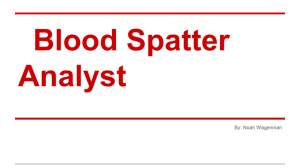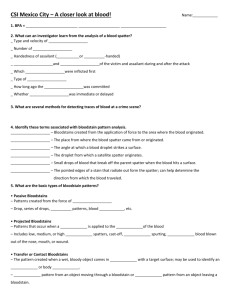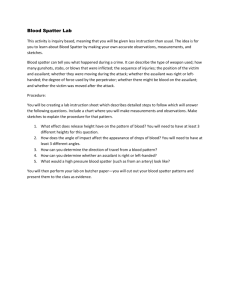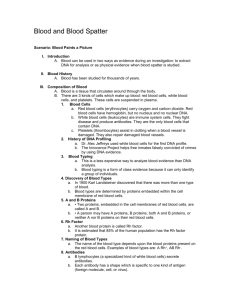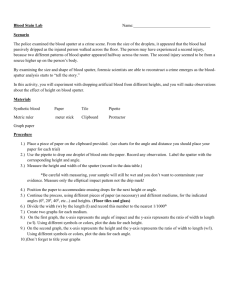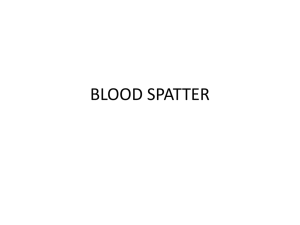Chapter 8 Exam review - Doral Academy Preparatory
advertisement
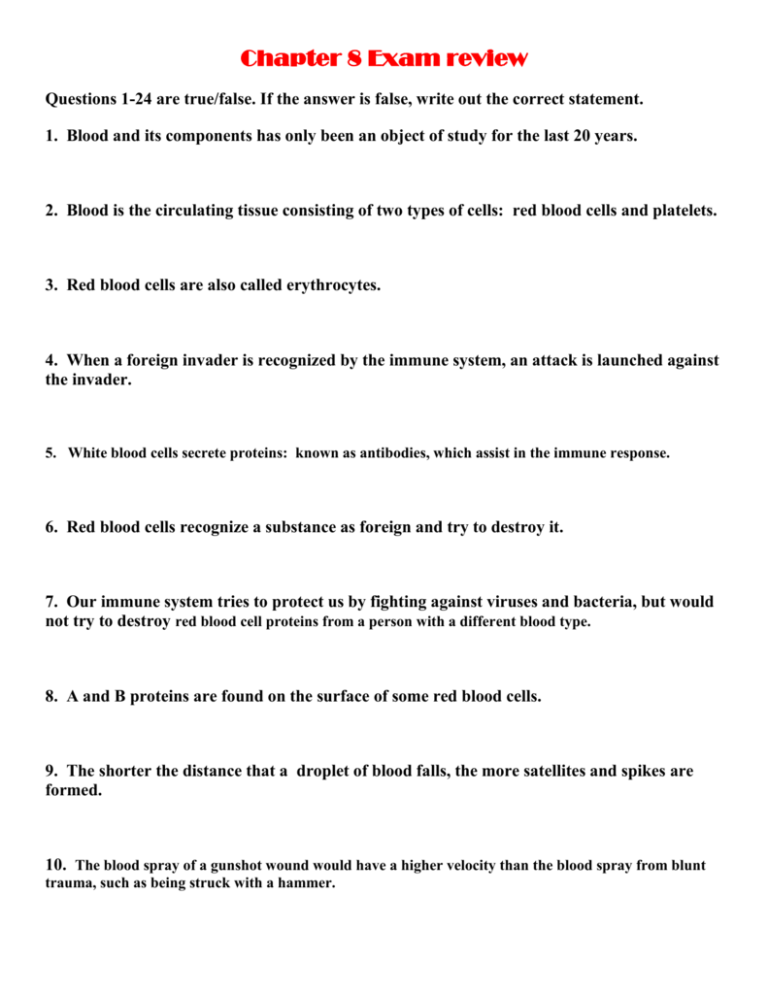
Chapter 8 Exam review Questions 1-24 are true/false. If the answer is false, write out the correct statement. 1. Blood and its components has only been an object of study for the last 20 years. 2. Blood is the circulating tissue consisting of two types of cells: red blood cells and platelets. 3. Red blood cells are also called erythrocytes. 4. When a foreign invader is recognized by the immune system, an attack is launched against the invader. 5. White blood cells secrete proteins: known as antibodies, which assist in the immune response. 6. Red blood cells recognize a substance as foreign and try to destroy it. 7. Our immune system tries to protect us by fighting against viruses and bacteria, but would not try to destroy red blood cell proteins from a person with a different blood type. 8. A and B proteins are found on the surface of some red blood cells. 9. The shorter the distance that a droplet of blood falls, the more satellites and spikes are formed. 10. The blood spray of a gunshot wound would have a higher velocity than the blood spray from blunt trauma, such as being struck with a hammer. 11. As the angle of impact increases, the length of the blood spatter increases. 12. The location of the victim when they were attacked can be determined by looking at the blood spatter. 13. The shape of the blood droplets can show us the direction that the perpetrator was moving. 14. The shape of the blood droplets can provide evidence of a sequence of events. 15. The shape of the blood droplets can show us who the victim was. 16. The type of weapon used in the attack can be determined by looking at the blood spatter. 17. The motive for the attack can be determined by looking at the blood spatter. 18. The height of the victim's injury or injuries can be determined by looking at the blood spatter. 19. Today, blood splatter evidence is used to explain events at violent crime scenes. 20. Today blood splatter evidence is used to explain events at all crime scenes. 21. Blood typing is usually used in an investigation before DNA analysis, because it is cheaper and can more accurately pinpoint the perpetrator than DNA testing can. 22. Except for identical twins, no two people on earth have the same DNA. 23. Chromosomes are structures made up of molecules of DNA, which store genetic information. Multiple Choice 25. Blood has been studied at one degree or another: since 1993. for thousands of years. for the last 4 decades. None of them can be. 26. Whole blood is composed of: white blood cells red blood cell Platelets All of the above. 27. Which part of blood aids in clotting? white blood cells red blood cell Platelets All of the above. 28. Antibodies are White blood cells secrete proteins: proteins secreted by viruses to attack the immune response. proteins secreted by white blood cells to assist in the immune response. proteins secreted by bacteria to assist in the immune response. proteins secreted by parasites to attack the immune response. 29. Erythrocytes: carry respiratory gases, mainly oxygen and carbon dioxide. fight disease and foreign invaders. aid in blood clotting. are involved in repairing damaged blood cells. 30. Which part of blood carries oxygen to body cells and carbon dioxide away? white blood cells red blood cell Platelets All of the above. 31. Which part of blood fights pathogens and infections? white blood cells red blood cell Platelets All of the above. 32. The part of blood that fights against pathogens and infections defend our bodies from: viruses. bacteria. red blood cell proteins from a person with a different blood type. All of these choices. 33. The immune system functions to protect our bodies by identifying cells or molecules that are foreign, such as: viruses. bacteria. parasites. All of these choices. 34. The blood type an individual has is determined by: a DNA reaction test. an antibody reaction test. a protein reaction test. a RF factor reaction test. 35. Of the four main human blood types using the ABO system, the smallest percentage of the U.S. population is made up of: Type O. Type A. Type B. Type AB. 36. What percentage of the population is made up of type A blood? 43% 42% 12% 3% 37. What percentage of the population is made up of type B blood? 43% 42% 12% 3% 38. What percentage of the population is made up of type AB blood? 43% 42% 12% 3% 39. What percentage of the population is made up of type O blood? 43% 42% 12% 3% 40. If the membrane of a person’s red blood cells contains the B proteins, then he or she has: Type A blood. Type B blood. type AB blood. type O blood. 41. If the membrane of a person’s red blood cells contains the A proteins, then he or she has: Type A blood. Type B blood. type AB blood. type O blood. 42. If the membrane of a person’s red blood cells contains both the A and the B proteins, then he or she has: Type A blood. Type B blood. type AB blood. type O blood. 43. If the membrane of a person’s red blood cells does not contain the A nor the B proteins, then he or she has: Type A blood. Type B blood. type AB blood. type O blood. 44. DNA can be extracted from: bodily fluids. skin cells. strains of hair. All of the above. 45. What is one thing that the shape of the blood drops tell the investigators? the identities of the victims the identity of the criminal the timeline of events None of these choices. 46. Which statement about blood droplets is true? The closer to the surface the droplet falls, the more satellites and spikes you will see. The further from the surface the droplet falls, the more satellites and spikes you will see. The distance from the surface has no determination over the number of satellites and spikes you will see. The amount of iron in the blood will determine the number of satellites and spikes you will see. 47. Which statement is true regarding blood spatter? The more blood in the spray, the larger the droplets in the spatter. The less blood in the spray, the larger the droplets in the spatter. The higher the velocity of the spray, the larger the droplets in the spatter. The lower the velocity of the spray, the larger the droplets in the spatter. 48. The greater the angle of impact (the bigger number of degrees), the more elongated the blood spatter becomes. the less elongated the blood spatter becomes. the less round the blood spatter becomes. the more spikes and satellites can be seen. 49. Which letter best shows the convergence point (origin point)? A B C D Use the image below to answer questions 50 – 52. This is an image of a few drops of blood, where the letter “A” represents the parts of the blood spatter that is separate from the main drop and the letter “B” represents the part of the spatter that is still attached to the drop. 50. What part of the droplet does the letter "A" represent? Gush Spike Satellite None of these choices. 51. What part of the droplet does the letter "B" represent? Gush Spike Satellite None of these choices. 52. What type of blood pattern is shown in this image? An arterial gush Splashes Passive drops Smears
